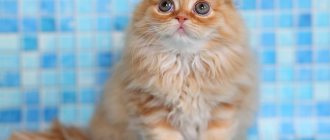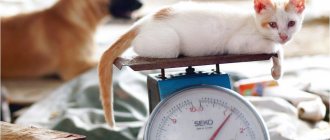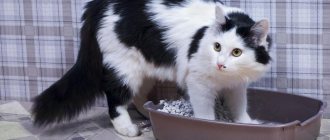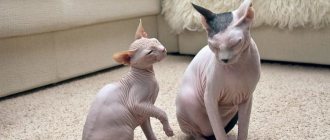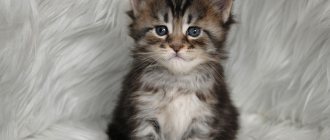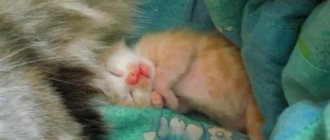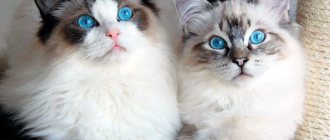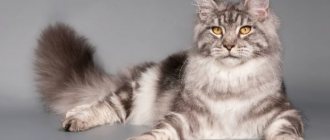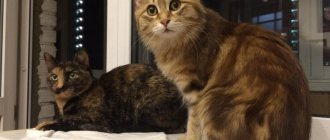Height or length?
Our smaller brothers walk on four legs, which creates some confusion when taking measurements. What is the difference between a pet's height and its body length?
As for body length, its value is measured in the horizontal direction.
Let's start taking measurements
Measuring the height of a cat is more difficult than measuring the height of a dog. A standard cat will not stand in one place for even a couple of minutes, so to take measurements you will need an assistant to hold the fidget.
The rest is a matter of technique. Place the cat close to the door frame or wall, level with the height of the withers, leave a mark with chalk, and then measure the distance from the floor to the mark made.
What to do if your pet desperately does not want to stand still for at least a minute, and there is no assistant nearby? Then you can use a trick and measure the animal’s height from a lying position.
What about the length?
Along with the height of the animal at the withers, the breed standards must indicate the length of its body. So in our story it would be unfair to ignore this parameter.
I recommend: How to remove a cat from a tree
Interestingly, data on body length allows us to determine the approximate age of the animal. Here are some approximate indicators for a medium-sized animal:
- newborn kitten – 12 cm;
- kitten aged 2 months – up to 24 cm;
- kitten aged 5-6 months – up to 35 cm;
- adult cat – up to 35 cm;
- adult cat – up to 37 cm.
This information will be useful if you adopted a kitten from the street and are now wondering what its approximate age is. But in this case, it makes no sense to measure height, since the length of the paws depends not so much on age, but on the genetic characteristics of the animal.
Additional measurements
To sew clothes for a cat or select ready-made cat equipment, you will need additional measurements:
Criteria for normal weight of cats and kittens
First of all, 3 factors influence a cat’s weight: its breed, age and lifestyle. For this reason, veterinarians do not recommend relying on a single standard. The norm calculated for a specific pet is much more reliable.
Breed affiliation
On average, domestic cats weigh 3.6-4.5 kg, but, depending on the breed, this figure freely “walks” up or down. For example, Maine Coons will always be larger than short-legged Munchkins, even at the kitten stage.
The constitution of the body is no less important. The norms for the “British” and “Scots” are practically the same, but the former are characterized by more developed muscles, and the latter by graceful proportions.
Differences are also observed within the breed. Most felines are characterized by pronounced sexual dimorphism. This means that a male can always be distinguished from a female thanks to the extra pounds. In most cases the difference is 1-2 kg.
Age
A cat's weight constantly changes as it grows. The minimum indicator is typical for kittens, but they gain new kilograms much faster and practically do not store fat.
By 1.5-2 years, weight stabilizes, and its deviation becomes undesirable. Older animals most often suffer from obesity and exhaustion, as metabolism slows down with age and the number of chronic diseases increases.
Nutrition and activity
Weight is affected not only by the amount of food eaten, but also by the quality of food and the frequency of meals. For this reason, homeless animals are more likely to suffer from thinness. In addition to irregular and meager nutrition, their lives are marked by excessive activity. Street cats are constantly in search of food and are forced to regularly defend their territory.
Pets live in maximum comfort. Their activity level depends on the efforts of the owners, breed and age. The main fans of games are the “Abyssinians” and “Orientals”, and the main admirers of the sofa lifestyle are the “British” and “Persians”. Because of this, the latter are more likely than others to suffer from obesity.
Slide captions:
Research article on the topic: “Measurement of the physical parameters of a cat” Completed by: Rogozhnikova Svetlana, 7th grade Supervisor: Osolikhin Yu. V., higher physics teacher. sq. cat. Branch of MKOU "Shamarskaya Secondary School No. 26" - "Gornaya Secondary School"
Study of light perception by the cat's eye Experiment No. Distance from source to device, cm Illumination, lux Pupil width, mm 1 5 250 6 2 10 120 9 3 15 70 11 4 20 30 13
Recommend: People are responsible for those they have tamed
Physical devices. Measuring tape, measurement limit 100 cm, division 1 mm.
Medical thermometer, measurement limit 43°C, division value 0.1°C.
Household spring scales, measurement limit 10 kg, division value 0.1 kg.
School ruler, measurement limit 20 cm, division 1 mm.
Flashlight on your phone, Sound Level Meter app on your phone.
Luxmeter 25 -100-500 lx with separate photocell F102, measurement range 25, 100, 500 lux, division value 0.5, 2, 10 lux.
Dosimeter “Master 1-Horizon B5656”, units. measurements μSv/h.
Shoe size
To find out which shoes are suitable for a cat, you need to take standard measurements of the length and width of the “feet”. The easiest way is to put your pet on a piece of paper and trace the front and back tracks. Afterwards, in a calm environment, without torturing the animal, you can determine the size of the shoes.
Important: paws, in most cases, differ in size from each other, so you should not rely on single readings.
Clothing for a cat is not a whim of the owner, but a necessity: hairless breeds are cold, short-haired ones need warmth when they are acclimatizing or sick. To prevent the fur from becoming electrified, when choosing clothes for a cat, preference is given to natural fabrics with a small synthetic content.
How to take measurements
When a cat sits or lies, the spine changes length due to deflection or twisting. Clothing for a cat is designed for movement, so measurements are taken after placing the animal.
It is better to measure together. The owner calls the cat, holding a treat in his palm. The palm of the other hand gently supports the stomach, preventing the animal from sitting down.
At this time, the assistant measures:
- the length of the back from the withers to the beginning of the tail (not the end of the body);
- neck circumference (the tape is placed in the middle);
- chest volume (widest point);
- volume of the abdomen (when the cat is expecting kittens, or the pet is well-fed).
Common clothing models are blouses with an elongated back or blankets with a hole for paws without sleeves. When you plan to purchase items with sleeves and legs, the circumference (volume) of the paws is measured.
Clothes for kittens are purchased for growth. It is better to check the measurement table for this breed, which records growth by month. Or purchase clothes by adding up to 4 cm for movement.
size table
Manufacturers conventionally divide all cat breeds into large, medium and small (L, M, S), and then make a breakdown in increments of 3-5 cm, referring to the control measurement of neck girth. Before purchasing, it is worth checking whether the table includes allowances for loose fitting - after all, the cat does not need tight-fitting clothes.
A couple of cm are added to the measured home values for freedom of movement of the animal, then the size is determined from the table.
Important: the choice of size also depends on the type of fabric. If the control measurements with an increase were obtained on the border of two sizes, choose the smaller one when the fabric stretches well (for example, knitted fabric, lycra, jeans with elastane).
If the table determines the size of the cat, and the planned purchase is a jumpsuit worn on four paws, additionally measure their girth.
Before paying for clothes in a pet store, ask the seller about the elasticity of the materials, if necessary, add a couple of centimeters for movement.
Possible reasons why a kitten’s weight does not correspond to age standards
The main reasons for a kitten’s weight not meeting age standards are:
- Lack of nutrition. The first months of life, kittens may suffer from a lack of milk. This may be due to an unbalanced diet of the cat or a large number of brothers and sisters of the baby.
- Unbalanced regime and diet of the kitten. In particularly advanced cases, the baby’s development stops.
- Deviations associated with genetics or heredity. This applies to a greater extent to purebred kittens. It is necessary to find out what diseases can be passed on to the baby from mom and dad. If a kitten is suffering from underweight, you should check with the breeder what parameters its parents had at the same age.
- Infectious diseases and viruses. Diseases can affect the kitten’s gastrointestinal tract, which affects the absorption of food. The absorption of beneficial elements deteriorates, so the baby may not gain weight.
- Worms. At any age, helminthic infestations are dangerous for an animal, and even more so during the formation of a young organism. If a kitten is infected with worms, it will not grow well.
In the last three cases, the owner must immediately contact a veterinarian to prevent possible death of the animal or the development of diseases and transition to chronic forms.
In order for the kitten to develop normally, it is necessary to consult a specialist and follow feeding recommendations. In addition, if some deviations in the baby’s development are noticed, immediate action must be taken. The delicate body of a kitten does not yet have the immunity of an adult animal, and many infections can seriously harm it.
Savannah
This animal amazes others with many of its characteristics, namely height, weight, etc. But the main surprise awaits those who decide to buy a kitten of this breed for themselves. The price is truly astronomical, although it is due to the fact that this breed has only 1 thousand individuals, and the first offspring were born only in the spring of 1986.
The basis of this breed was the domestic cat and the wild African serval. As a result, an animal was born, distinguished by its unique color, large ears, long legs, as well as fantastic jumping ability (up to 3 meters) and love for the water element. Savannah not only loves to swim, she is an excellent swimmer and is able to cover enormous distances across the surface of the water.
In addition, the Savannah has a developed intellect, she has an easy-going character and is devoted to her owner.
Obesity
© shutterstock
Like very low weight cats, obese cats require immediate attention. These cats have several health problems, including heart disease, diabetes, kidney disease and more, which shorten their lives. The extra weight will also take a toll on the joints, making it difficult for your cat to climb and jump as usual. The added fat can also make it difficult for your lungs to expand and breathe normally. You may also notice your cat snoring more often. In a fat cat, it will be difficult to feel the ribs and you will see clear fat deposits in the lower back, face and limbs. There will be no visible waist, a very noticeable round belly area with thick fat padding, and the backside will bulge out when viewed from above.
Chausie
It is considered not only one of the largest, but, at the same time, the rarest breed, the weight of which can reach at least 14 and a half kilograms.
The breed was born in 1990 and is a hybrid of an Abyssinian cat and a jungle cat. The jungle cat prefers to live in swamps, which is why it is also called the swamp lynx.
As a result of hard work, breeders managed to get a cat that has the power of a predator and the docile nature of a domestic cat. Chausie cats are quite strong cats, with an athletically complex body, a large (comparatively) head, large ears, and green or yellow eyes. Despite such external characteristics, the breed is devoted to its owner and feels great around children.
